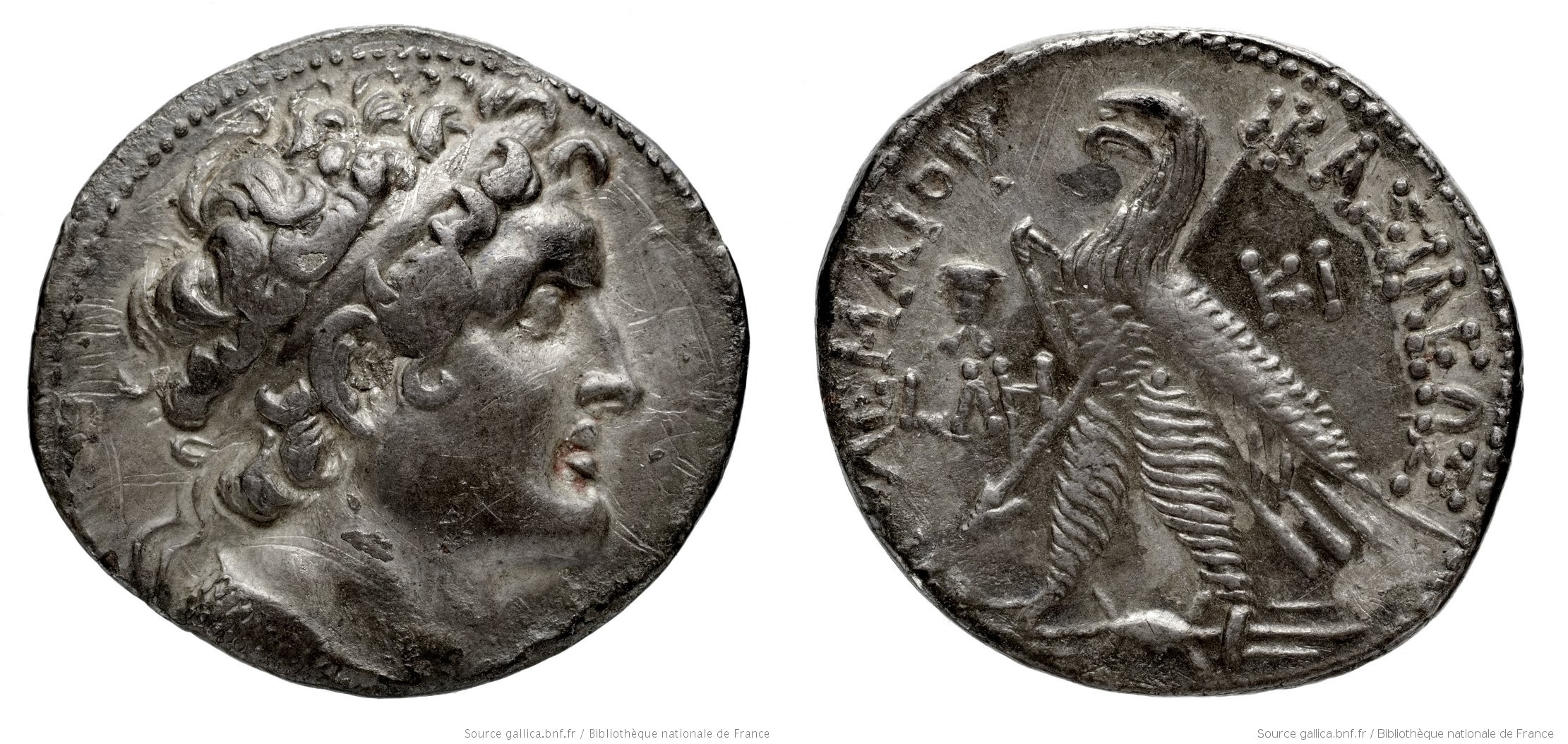S 622 - Citium (Ptolemy VIII), silver, tetradrachms (145-116 BCE)
From SILVER
145 BCE - 116 BCE Silver 18,412 kg
Description
| ObverseInscription or printing placed on the obverse.: | Head of Ptolemy I Soter to right, wearing diadem and aegis around neck. |
| ReverseInscription or printing placed on the reverse.: | ΠΤΟΛΕΜΑΙΟΥ ΒΑΣΙΛΕΩΣ (Greek).Eagle standing to left on thunderbolt, (thyrsos or scepter on shoulder). In field, date (and star (sometimes under eagle), aplastron, diademed petasos, ear of cereal, helmet, diademed grain baskett, AI with two stars or club). |
Mint and issuing power
| MintIdentifies the place of manufacture or issue of a numismatic object.: | Citium | Ancient regionAncient region.: | Cyprus | Modern countryModern country: Greece | AuthorityIdentifies the issuing power. The authority can be "pretended" when the name or the portrait of X is on the coin but he/she was not the issuing power. It can also be "uncertain" when there is no mention of X on the coin but he/she was the issuing power according to the historical sources: | Ptolemaic dynasty (323-30 BC), Ptolemy I Soter (satrap and Ptolemaic king of Egypt, 323-305 BC), Ptolemy VIII Physcon (169-164, 144-132/1 and 126-116 BC) |
Chronology
| FromIdentifies the initial date in a range assigned in a numismatic context. | 145 BCE | toIdentifies the final date in a range assigned in a numismatic context.. | 116 BCE | PeriodTime period of the numismatic object.: Hellenistic 323-30 BC |
Physical description
| MetalThe physical material (usually metal) from which an object is made.: | Silver |
Median weightMedian of the weights of numismatic objects (in grams). in grams | 14.10 | DenominationTerm indicating the value of a numismatic object. Examples: tetradrachm, chalkous, denarius.: | tetradrachm |
StandardStandard.: | Ptolemaic |
Image

S 622 Citium Ptolemy VIII Tetradrachm 145-116 BCE.jpg [1]
References
| Die study referencePublication of the study: | Olivier 20121Olivier 2012, p. 94-107, no. 1240-1749. | ||
| Coin series referenceReference to coin series study: | |||
Obverse dies distribution
| FrequencyFrequency of specimen in distribution. ᵖ | Number of obversesNumber of obverse dies. ᵖ (o) | % (o) | Number of coinsNumber of coins. (n) | % (n) | Die nameName(s) of the die(s). |
| 1 | 8 | 12.7 | 8 | 1.57 | D247, D253, D260, D261, D262, D271, D277, D302 |
| 2 | 2 | 3.17 | 4 | 0.78 | D167, D289 |
| 3 | 9 | 14.29 | 27 | 5.29 | D169, D249, D250, D254, D258, D259, D274, D286, D301 |
| 4 | 4 | 6.35 | 16 | 3.14 | D248, D251, D269, D280 |
| 5 | 4 | 6.35 | 20 | 3.92 | D255, D264, D276, D299 |
| 6 | 1 | 1.59 | 6 | 1.18 | D300 |
| 7 | 2 | 3.17 | 14 | 2.75 | D257, D293 |
| 8 | 4 | 6.35 | 32 | 6.27 | D252, D263, D268, D284 |
| 9 | 5 | 7.94 | 45 | 8.82 | D252, D263, D268, D284 |
| 10 | 1 | 1.59 | 10 | 1.96 | D296 |
| 11 | 2 | 3.17 | 22 | 4.31 | D283, S290 |
| 12 | 6 | 9.52 | 72 | 14.12 | D265, D267, D272, D278, D281, D287 |
| 13 | 5 | 7.94 | 65 | 12.75 | D170, D270, D282, D292, D297 |
| 14 | 3 | 4.76 | 42 | 8.24 | D245, D275, D291 |
| 15 | 3 | 4.76 | 45 | 8.82 | D165, D288, D295 |
| 17 | 2 | 3.17 | 34 | 6.67 | D246, D266 |
| 23 | 2 | 3.17 | 46 | 9.02 | D294, D303 |
| Total | 63 of 63 | 99.99 | 508 of 510 | 99.61 |
Reverse dies distribution
no distribution is available
Quantification
| Number of obversesNumber of obverse dies. ᵖ (o) | 63 | Number of singletons (o1)The number of singleton coins. ᵖ | 8 |
| Number of reverse diesNumber of reverse dies. (r) | 277 | Number of coinsNumber of coins. (n) | 510 |
| Coins per obverse dieNumber of coins per obverse die. (n/o) | 8.1 | Coins per reverse dieNumber of coins per reverse die. (n/r) | 1.84 |
| Reverse per obverse ratioRatio of obverse dies divided by reverse dies. (r/o) | 4.4 | Percentage of singletons (o1)number of coins (n) divided by the number of singletons (o1) ᵖ | 12.7 % |
| Original number of dies (O) (Carter 1983 formula)The estimation of the number of coins according to Carter 1983 ᵖ | 65.29 | Coins struck if 20,000 as average productivity per dieCoins made if the average productivity for obverses (according to Carter) is 20,000. ᵖ | 1,305,800 |
| Original number of dies (O) (Esty 2011 formula)The estimation of the number of coins according to the singleton formula in Esty 2011 ᵖ (O) | 71.88 | Survival rate if 20,000 as average productivity per dieSurvival rate if average productivity is 20,000. ᵖ | 0.00039 |
| Coverage (o = % of O) (Esty 1984 formula)Esty 1984 - coverage (% of O) ᵖ (o = % of O) | 98.43% | Die productivity if survival rate 1/2,000Average productivity if survival rate is 1/2,000. ᵖ | 15,622.61 |
| Weight of silver (in kg) if 20,000 coins per die (O = Carter formula)Carter 1983 * Median weight * 20000 (*10 if gold or electrum) ᵖ | 18,412 kg <br /> 18,412 kg | Die productivity if survival rate 1/5,000Average productivity if survival rate is 1/5,000. ᵖ | 39,056.52 |
Remarks
References
- ^ Olivier, Julien (2012), Archè et Chrèmata en Egypte au IIe siècle avant J.-C. (204-81 av. J.-C.). Etude de numismatique et d'histoire, [Unpublished doctoral dissertation], Orléans University, 2012.